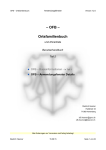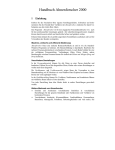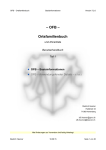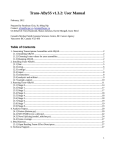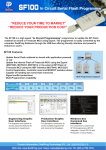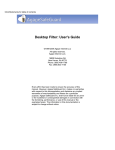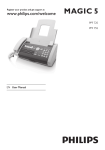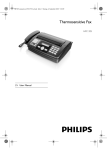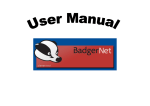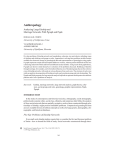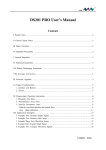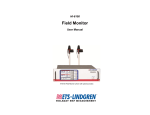Download – OFB – Service Programs
Transcript
OSP – Part 2
Gedcom Profile Management – V: 7.2.1
– OFB –
Service Programs
User Guide
Part 2
OFB – Start Center – in Part 1
OFB – Color/Font Management – in Part 1
OFB – Gedcom Profile Management
Diedrich Hesmer
Haldenstr 24
71083 Herrenberg
All changes to the previous version are colored
Diedrich Hesmer
10/29/15
Page 1 of 25
OSP – Part 2
Gedcom Profile Management – V: 7.2.1
Table of Contents
1 Introduction...........................................................................................................................................3
1.1 Gedcom Definitions............................................................................................................................. 3
1.2 Gedcom Profile file.............................................................................................................................. 3
2 Main Screen..........................................................................................................................................4
2.1 Tab "General + Gedcom Interpret (1)"................................................................................................. 5
2.1.1 Tab "General".............................................................................................................................. 5
2.1.2 Tab "Place of Citizenship"............................................................................................................ 5
2.1.3 Tab "Place of Residence"............................................................................................................ 6
2.1.4 Tab "Relationship"....................................................................................................................... 6
2.1.5 Tab "Family Name"...................................................................................................................... 7
2.1.6 Tab "None-marital Relationship".................................................................................................. 7
2.2 Tab "Gedcom Interpret (2)................................................................................................................... 9
2.2.1 Tab "Adoption + Parent-Child Relations".....................................................................................9
2.2.2 Tab "Address"............................................................................................................................ 10
2.2.3 Tab "Occupation / Divers".......................................................................................................... 11
2.2.4 Tab "Rufname / RefId-nbr"........................................................................................................ 11
2.2.5 Tab "Privacy Protection Individual"............................................................................................12
2.3 Tab "Tags Standard + Addition"......................................................................................................... 13
2.3.1 Tab "Standard INDI groups"...................................................................................................... 13
2.3.2 Tab "Standard FAM + LDS"....................................................................................................... 14
2.3.3 Tab "Special Group".................................................................................................................. 14
2.3.4 Tab "Tags 1 added"................................................................................................................... 15
2.3.5 Tab "Tags 2 added"................................................................................................................... 16
2.4 Tab "Tags Skipped + Options"........................................................................................................... 17
2.4.1 Tab "Tags/Events skipped"........................................................................................................ 17
2.4.2 Tab "Sub Tags skipped"............................................................................................................ 17
2.4.3 Tab "Further Options"................................................................................................................ 18
3 Appendix.............................................................................................................................................20
3.1 Basics of Gedcom Specification........................................................................................................ 20
3.2 Standard Tags – handled by OFB...................................................................................................... 20
3.3 Hints to create a Profile file................................................................................................................ 25
Diedrich Hesmer
10/29/15
Page 2 of 25
OSP – Part 2
Gedcom Profile Management – V: 7.2.1
1 Introduction
This document is the part 2 of the “OFB Service Programs” User Guide. Beside the program „OFB Gedcom
Profile Managent“ the basics of the Gedcom Specification is included.
The details for
● Introduction
● Copyrights and License Conditions
● Support, Download & Installation
● Start of Program
● Gedcom file (ged-file)
are described in part 1 of the document.
1.1 Gedcom Definitions
The Gedcom theme is a complex item. Therefor a base knowledge to a certain extent is required to use the
program. For a better understanding and to support you during creation of a Gedcom profile a short
introduction is available in the appendix.
1.2 Gedcom Profile file
Gedcom Profile files (ogp-file) are created and managed by the Service Program "OFB-GedcomProfil.exe".
They contain all criteria, options and rules defined by the following screen tabs for transferring the genealogy
data from the ged-file to the OFB. The file must be stored for use by the OFB program. A name should be
chosen which relates to the genealogy program providing the ged-file, e.g. "paf.ogp" for the ged-file created
by the program "PAF". For each genealogy program providing a ged-file usually 1 or more (with different level
of details for reading the data) file(s) are needed. It is recommended, to store all ogp-files in the program
folder of the OFB. It is recommended to store all ogp-files in a common folder, e.g. "C:\Data\OFB\files\").
For creation of the Profile file the program "Structure Analysis" will help. Selecting the option "Marking of
potential OFB structures" will add appropriate markings in the list. On demand I'll create the Profile file for
you. For that I need your ged-file.
Diedrich Hesmer
10/29/15
Page 3 of 25
OSP – Part 2
Gedcom Profile Management – V: 7.2.1
2 Main Screen
After starting the program, the following main screen will show up. The last used profile file will be reloaded.
Fig 1: Main screen + Tab "General"
This screen has 16 tabs, divides into 4 base tabs each containing 2-5 sub tabs, and allows the viewing and
management of the Gedcom profile:
1 tab to select the data elements, which require a special Gedcom definition and to select the data groups
with standard Gedcom tags.
10 tabs by which the handling of the Gedcom tags for the specific data elements will be defined, which
require a genealogy program specific interpretation during reading of the raw data.
2 tabs are used to select Standard Gedcom Tags within 4 groups.
2 tabs to define additional – most likely user defined – level-1 and -2 tags.
2 tabs to define tags and events, which should be skipped during analysis or for exclusion for the log file.
1 tab for selection of additional options.
Below the tabs is the group field for initializing, loading and storing the profile file (ogp-file)
● Pushing
all fields will be set to their initial value.
● Pushing
a Gedcom-Profile file will be loaded.
● Pushing
a folder (e.g. "C:\Data\OFB\files\") and name for the Gedcom profile file will be defined and
the file stored as "ogp-file". This file contains all settings specified by all the tabs for reuse.
● Pushing ? will load this user manual.
● Pushing the Home will open the OFB Homepage by the browser.
● Pushing Edit Def a summary list of all selected options and definitions will be created and opened by the
text editor. The file name of the list will be the name of the profile-file with the extension ".txt" and will be
stored in the folder of the profile-file.
● Pushing Del Def will delete the data-log file.
Diedrich Hesmer
10/29/15
Page 4 of 25
OSP – Part 2
Gedcom Profile Management – V: 7.2.1
● Pushing Close will close the program. The storage location and name of the current profile file will be
written to an ini-file to be available for the next program start. If profile data have been changed
confirmation dialog for data saving will pop up. Note: This button is active only, if no text is present at the
4 entry fields of the tabs "Tags 1 / 2 added" and "Tags/Events skipped".
● Messages will be written to the status bar at the bottom of the window.
2.1 Tab "General + Gedcom Interpret (1)"
Contains 6 tabs
2.1.1 Tab "General"
2 group boxes for general definitions are available:
● For special interpretation of the standard tags and the user-defined tags 6 tabs are supporting you to get
a correct transfer to the OFB database. Select the data elements at Special Gedcom Definitions for...
Only selected data elements will be activated for input in the tabs, and only the selected data elements will
be analyzed by the OFB.
Because the official Gedcom specification isn't precise enough in all cases and also allows user-defined
tags, the various genealogy programs are generating slightly different Gedcom files. For compensation
the following tabs are used. For each of the definition groups select 1 method and enter the required tags
and/or attributes, as they are used in the "ged-file".
● For the transfer of Standard Gedcom Tags to the OFB database 2 tabs are available. Select the groups at
Standard Gedcom Tags for... Only selected groups will be activated for input in the tabs. The available
tags for each group are shown in the tables 5 to 6.
2.1.2 Tab "Place of Citizenship"
Fig 2: Tab "Place of Citizenship"
Place of Citizenship is an important parameter in Switzerland. However this will not be supported by all
genealogy programs. No standard tag available.
● Enter the tag resp. attribute for the Place of Citizenship according to the handling in the INDI data record
of the genealogy program.
Diedrich Hesmer
10/29/15
Page 5 of 25
OSP – Part 2
Gedcom Profile Management – V: 7.2.1
2.1.3 Tab "Place of Residence"
Fig 3: Tab "Place of Residence"
Place of Residence will not be supported by all genealogy programs. No standard tag available.
● Enter the tag resp. attribute for the Place of Residence according to the handling in the INDI data record
of the genealogy program.
If method "User Tag with PLAC" is selected and OCCU as tag defined, for OCCU without attribute the
attribute of PLAC will be used as Place of Residence.
Note: If OCCU is followed by an attribute, the attribute of PLAC will be used as place for the defined
occupation.
2.1.4 Tab "Relationship"
Fig 4: Tab "Relationship"
Defines the handling of relations between 2 persons or FAM event and a person.
● For User Tag with TYPE the "1 BIRT / CHR / ..." stands for the events birth, christening, death, burial
resp. marriage, divorce. The expression will also be processed, if the subtag TYPE is not available.
● Tag 1 ASSO with _EVN is intended to be used for the data from "Brothers Keeper" to process these
relations.
● The relationships will always be assigned to person INDI resp. family FAM. Here the Tag 1 ASSO and
Tag 2 ASSO both can be selected together. The text for "Naming" and "xxx" may be modified by the
Diedrich Hesmer
10/29/15
Page 6 of 25
OSP – Part 2
Gedcom Profile Management – V: 7.2.1
Naming form. This option is also valid for "_ASSO", because during reading by the OFB the "_ASSO" will
be converted to "ASSO".
● Tag 1 ALIA will be used for the link between 2 probable identical persons and the 2 nd person is
referenced by the tag. This option can be selected in addition to the others except with "1 Tag ASSO with
_EVN". The OFB uses "Alias" as "Naming".
Note: If this option is selected, the OFB will also output the relations of "Tag 1 ASSO".
2.1.5 Tab "Family Name"
Fig 5: Tab "Family Name"
Family name by marriage: will not be supported by all genealogy programs. No standard tag available.
● Enter the tag resp. attribute for the Family name according to the handling in the INDI data record of the
genealogy program.
Use Surname of partner if no family name is stored in the ged-file: In cases, where no family name is
stored in the ged-file according above defined method, the surname of the partner can be inserted as family
name. For multiple partnership the surname of the first or last partner can be selected.
2.1.6 Tab "None-marital Relationship"
Fig 6: Tab "None-marital Relationship"
None-marital relationship: This information will be used by the OFB to insert the genealogy signs correctly.
By means of a status information in the FAM data record an appropriate decision will be attempted. Doing
this for:
Diedrich Hesmer
10/29/15
Page 7 of 25
OSP – Part 2
Gedcom Profile Management – V: 7.2.1
Method 1: a user-defined tag with the attribute for "NOT-married" (here "PARTNERS") will be used. For each
FAM record matching this definition, the decision is "none-marital Relationship", otherwise "marital".
Method 2: a user-defined tag with the attribute for "married" (here "MARRIED") will be used. For each FAM
record matching this definition, the decision is "marital Relationship", otherwise "none-marital".
Method 3: an attribute for "NOT-married" (here "Gemeinschaft") will be used. For each FAM record matching
this definition, the decision is "none-marital Relationship", otherwise "marital". This method will be used for
both, the combination MARR.TYPE and also EVEN.TYPE.
These status informations will not be supported by all genealogy programs. No standard tag available. If no
decision can be made by these methods, a simplified insertion of the genealogy signs will be done – see
OFB User Guide.
● Enter the tag resp. attribute according to the handling in the FAM data record of the genealogy program –
either TYPE for MARR or TYPE for EVEN..
Diedrich Hesmer
10/29/15
Page 8 of 25
OSP – Part 2
Gedcom Profile Management – V: 7.2.1
2.2 Tab "Gedcom Interpret (2)
Contains 5 tabs.
2.2.1 Tab "Adoption + Parent-Child Relations"
This tab contains 2 sub-tabs and is used for the definitions for Adoption and other special Parent-Child
relations.
Tab "Adoption"
Fig 7: Tab "Adoption + Parent-Child Relations"
This allows to define the special handling of "adoption" by various Genealogy programs, e.g. Ages, FTM,
Brothers Keeper, MacStammbaum, etc. Independent of the selection the standard methods always will be
used in addition.
● Select the method according to the handling by the genealogy program. Multiple selections are allowed. In
case of the ADOP + PLAC Tag the OFB will use the attribute text xxx of PLAC as "adopted by ...".
● For the methods "Attribute 1+2" the system values "adopted" and "adoptiert" always will be used. Further
term belonging to this group can be entered. The input should be in lower case, multiple entries separated
by a semicolon.
Tab "Other Parent-Child Relations"
Fig 8: Tab "Other Parent-Child Relations"
The methods for "Attribute 1+2", selected for "Adoption" will also be used here. Beside "adopted" 4 additional
Diedrich Hesmer
10/29/15
Page 9 of 25
OSP – Part 2
Gedcom Profile Management – V: 7.2.1
groups will be created. As attribute terms xxx the OFB will process following terms (english + german) for the
groups:
●
birth = birth, biological, natural, geburt, biologisch, natürlich, leiblich, ehelich
●
uncertain = uncertain, unknown, questionmark (?), unsicher, unbekannt
● adopted = adopted, adoptiert (see 1st tab)
● foster = foster, pflege
● others = all others found
Further terms, belonging to the groups, can be entered. The input should be in lower case, multiple entries
separated by a semicolon.
Hints for the OFB output:
The output by the OFB will be in the format "{Attribute term} {Name of the parent} <link>", without the braces.
Therefor the terms should be adjusted by the OFB Naming file by data group "Relations". Exceptions are the
groups "birth", which will be skipped by the OFB output (these are the natural parents and an output would
increase the OFB size), and "adopted" which are processed separately. Examples for the modification of
terms are:
● term = "FOSTER" (as in ged-file written), New = "Foster child of"
● term = "uncertain" (as in ged-file written), New = "Uncertain relation to"
At the output the 1st word of the new text will be written in italics.
2.2.2 Tab "Address"
Fig 9: Tab "Address "
● Select the method according to the handling in the INDI data record of the genealogy program.
● Selection of the additional tags, to be included in the analysis. These are also used for the REPO-
(repository)-data records.
The Gedcom specification allows the use of CONT as sub-tag of ADDR, as well as the detailed storage by
ADRi, POST, CITY, … If both methods are used within 1 file, the detailed method will be used by the OFB.
Diedrich Hesmer
10/29/15
Page 10 of 25
OSP – Part 2
Gedcom Profile Management – V: 7.2.1
2.2.3 Tab "Occupation / Divers"
Fig 10: Tab "Occupation / Divers"
Occupation:
In addition to the standard tag "OCCU" a special definition can be made.
● Enter the attribute according to the handling in the INDI data record of the genealogy program.
The "xxx" will be used as name of the occupation.
Diverse entries:
is intended to be used for the data from "Ahnenforscher"
● All data of an INDI data record complying with the user-defined tag (here "_DIVERSES") and having the
sub tags "TITL" and "NOTE", will be combined for the output in this group. W ill not be supported by all
genealogy programs. No standard tag available.
● Enter the user-defined tag for this group according to the handling in the INDI data record of the
genealogy program.
2.2.4 Tab "Rufname / RefId-nbr"
Fig 11: Tab " Rufname / RefId-nbr."
At times Rufname (Call name) was in official German documents in case of multiple given names the
underlined part of the given names, not to be mixed up by nickname. This will not be supported by all
genealogy programs. No standard tag available. Following methods are available:
● Enter the level-2 "Tags" of the INDI record containing the "Rufname".
Diedrich Hesmer
10/29/15
Page 11 of 25
OSP – Part 2
Gedcom Profile Management – V: 7.2.1
● Enter the left and right enclosing character of the "Rufname" within the NAME tag. They might be
different. If only 1 char at end or beginning is used, enter a space as other character.
● Selection of NAME, EVEN or FACT Tag containing as attribute the "Rufname" and enter the attribute text
of the TYPE tag.
RefId-nbr:
Enter the level-1 tag for a free selectable Numbering system according the handling in the INDI data record
of the genealogy program. Usually REFN or IDNO will be used.
2.2.5 Tab "Privacy Protection Individual"
Fig 12: Tab " Privacy Protection Individual "
In opposite to the general privacy protection, where all persons will be handled the same way, the Privacy
Protection Individual allows a person related marking, e.g. if in some cases the general rules are
suspended or intensified by an individual agreements (in writing) with the concerned persons. 4 different
code values (severity) can be handled by the OFB. These are: "1"=release of all data, "2"=reduced
publication (1.char of given name, surname, sex, only years for * ~ + =), "3"=anonymous publication
("Anonymous" instead of name, sex, death sign if died), "4"=suppress person (will be eliminated out of the
database of the OFB). No standard tag available.
● Enter the tag resp. attribute for this data value according to the handling in the INDI data record of the
genealogy program.
Diedrich Hesmer
10/29/15
Page 12 of 25
OSP – Part 2
Gedcom Profile Management – V: 7.2.1
2.3 Tab "Tags Standard + Addition"
Contains 5 tabs.
For the next 2 tabs applies:
For the output for each group all selected tags with their sub-tags shown under "Explanation" will be
concatenated, separated by comma, in the sequence defined by the OFB. The naming of the tags – used for
output – is listed right of the "=" and will be read from the language file. This text may be differ to the naming
defined by the OFB naming file, because this program has no access to the naming files. Pushing
and
all tags can be selected or deselected, pushing
and
previously marked individual tags can be selected
or deselected. In each list box the tags are in alphabetic order.
Note: Deselected tags should be added also at 2.4.1 Tab "Tags/Events skipped" at Tags bypassed in log file
to avoid an entry in the log file.
2.3.1 Tab "Standard INDI groups"
The group INDI Attribute Structure provides the tags of table 5.
Fig 13: Tab "Std INDI"
The group INDI Event Structure provides the tags of table 6.
Both groups will be listed in the output as part of the data of the person.
The level-2 tags listed under "Explanation" will be processed. They can be excluded partly by the tab "Tags /
Events skipped".
Diedrich Hesmer
10/29/15
Page 13 of 25
OSP – Part 2
Gedcom Profile Management – V: 7.2.1
2.3.2 Tab "Standard FAM + LDS"
Fig 14: Tab "Std FAM + LDS"
The group FAM Structure provides the tags of table 8. The data of this group will be listed in the output as
part of the data of the marriage/partnership.
The group LDS Structure provides the tags of table 9. The data of the tag SLGS will be listed in the output as
part of the data of the marriage/partnership, all other tags as part of the data of the person.
The level-2 tags listed under "Explanation" will be processed. They can be excluded partly by the tab "Tags /
Events skipped".
2.3.3 Tab "Special Group"
Fig 15: Tab "Special Group"
This are 2 special data groups for data of persons out of the INDI data records and data of partnerships/
marriages out of the FAM data records. Each line defines 1 parameter. Each parameter can be assigned to
the INDI as well as to the FAM group. Each parameter is more or less freely selectable. For the definition 1 or
2 tags can be used. These corresponds to 1 or 2 data lines of the ged-file. The attribute text of the entered
tag will be used as value of the parameter, as title the naming will be used.
For each data element one of the 2 approaches may be applied:
1. the level-1 tag TAG_1 is followed by an attribute: enter TAG_1, TAG_2 stays empty
2. the level-2 tag TAG_2 is followed by an attribute: enter TAG_1 and TAG_2
Diedrich Hesmer
10/29/15
Page 14 of 25
OSP – Part 2
Gedcom Profile Management – V: 7.2.1
For each parameter entered, also enter the corresponding naming. The output will be "Naming: text".
Pushing X will blank all fields.
This group was designed especially for user-defined tags, but also for the level-1 tags NAME, HUSB and
WIFE and tags bypassed in OFB can be selected here, e.g. CHAN with the sub tag DATE.
Note:
Currently the following level-1 tags can NOT be used at this point:
ADDR, ADOP, ASSO, EVEN, NOTE, OBJE, RESI, SOUR, the tag for Ref-Id (if selected) and all tags
selected at the following "... for grouping standard tags".
Following level-1.level-2 tag combinations should not be used:
Level-1 tags CHIL and FAMC with level-2 tags PEDI, _MREL, _FREL, ADOP. These already will be
processed by the data field "Adoption".
Never define a data value 2 times, e.g. at "Special Group" and in parallel at "Tags added". If possible a data
value should be defined at "Tags added".
For the next 2 tabs applies:
Most of the genealogy programs create their own user-defined tags or are misusing standard tags. Therefor
these additional required level-1 and level-2 tags can be defined here:
● Select the group
● Enter the level-1 tag at TAG_1 resp. level-2 tags at TAG_2
Note: As long as text is present at entry fields TAG_1 resp. TAG_2, a red error message will shop up and
the button "Close" is disabled.
● Enter the text for naming – will be printed in the output before the text of the data field. Naming may stay
empty. A ":" will be added by the OFB. This field may stay empty.
Pushing
right of the "Naming" text all entered data will be transferred to the group selected. Up to 6 tags
can be added to each group.
Pushing
right of the "Naming" text a selected tag of a group will be moved to the area of data entry. Here
you can e.g. modify the data and transfer them back to a group.
Pushing
and
above the "Entry / Modification" text a selected item in 1of the 4 list groups will be moved
up or down by 1 position and will impact the sequence of the output.
Pushing X at top right near "NOTE Structure" will clear all fields of the additional level-1 resp. level-2 tags.
Pushing X at bottom right the "Naming" input field will clear the fields TAG_1 resp. TAG_2 and Naming.
2.3.4 Tab "Tags 1 added"
Fig 16: Tab "Tags 1 added"
3 standard groups "INDI Attribute", "INDI Event" and "FAM Structure" and the 3 date records "NOTE", REPO"
and "SOUR" are available.
Diedrich Hesmer
10/29/15
Page 15 of 25
OSP – Part 2
Gedcom Profile Management – V: 7.2.1
For the tags of the 3 standard groups all level-2 tags of the std group, the additional level-2 tags and a NOTE
record in the form "1 TAG_1 @Nxx@" (example: for "1 _HIST @N12@" the note stored under N12 will be
added 1st to the tag) will be analyzed.
For the tags of the 3 data records only the additional level-2 tags, defined in the following tab, will be
analyzed.
2.3.5 Tab "Tags 2 added"
Fig 17: Tab "Tags 2 added"
Available groups are the "Standard Group", the "NAME group" for the NAME tag, the "BIRTH, CHR, DEAD,
BURI group" for these tags of the INDI data records and the "MARR, DIV group" for these tags of the FAM
data records. The content of the tags will be added to the relevant group, to the Addition for names resp. the
Addition for the comment of the events.
The entered tags will be processed at all level-1 tags of the group. For the additional lvl-2 tags only the lvl-3
tags CONT and CONC will be processed.
If a naming of a data field always should start on a new line, place a "<br>" immediately in front of the text.
Instead of a naming the data element can be enclosed by parentheses [ ] , ( ) , { } or < > instead of a leading
text. The 1st character is the opening parenthesis and all following text will be ignored. Exception: If "<" is the
1st character, the OFB will check the existence of ">" and will assume a html tag (e.g. "<br>" for line break)
and will use the whole text.
Diedrich Hesmer
10/29/15
Page 16 of 25
OSP – Part 2
Gedcom Profile Management – V: 7.2.1
2.4 Tab "Tags Skipped + Options"
Contains 3 tabs.
2.4.1 Tab "Tags/Events skipped"
Note: As long as text is present at entry fields "Enter Tag ..." resp. "Enter Text ...", a red error message will
shop up and the button "Close" is disabled.
Fig 18: Tab "Tags/Events skipped"
● Tags bypassed in log file
defines tags, which will not be transferred to the log file, even in case of their ambiguous data . This is
especially helpful during debug of a new Gedcom profile file to reduce the size of the log file.
Enter the tag in the form:
"Level-nbr blank Tag". The name of the Tag may end with a "*" as place holder. If "3 _LIST*" is defined,
all Tags starting with "3 _LIST" will be considered.
To skip none-standard records, these have to be entered in the format "0 RecordName".
Pushing
the entered data will be checked and transferred to the list if they are accepted. In case of an
error (entry already in list, Level not "0-9", Tag doesn't start with "A-Z" or "_"), the text will show up in red
color and has to be corrected according the required format. The tags in the list are sorted in alphabetic
order.
Pushing
all tags will be deleted, pushing
only selected tags will be deleted.
● Event types skipped
defines events, which should not be used for output. All events where the attribute of their TYPE tag is
identical to the entered list will be skipped
Entry of the text for the attribute (e.g.. "edited by" for the tag "1 EVEN" with the sub-tag "2 TYPE edited
by").
Pushing
the entered data will be transferred to the list.
Pushing
all tags resp. event types will be deleted, pushing
only selected tags resp. event types will
be deleted.
2.4.2 Tab "Sub Tags skipped"
Usually not all sub tags will be used for an OFB output. This can be defined here.
● Sub-Tags to be excluded from
allows to deselect several sub-tags for output. The selected tags will not be analyzed in their main tag.
Please note:
○ The criteria defined here for Std groups will also be applied for Place of Citizenship and Place of
Residence.
○ If "CALN" at "REPO" is selected, "MEDI" also will be excluded.
Diedrich Hesmer
10/29/15
Page 17 of 25
OSP – Part 2
Gedcom Profile Management – V: 7.2.1
Fig 19: Tab "Sub Tags skipped"
○ The "DATA" of SOUR concerns only those DATA with a level nbr. > "1".
○ Media as sub-tag of SOUR can only be selected/deselected by the OFB option screen for media.
○ The marked tags of PLAC / _LOC apply for the sub-tags of the PLAC tags and for the tags of the
_LOC records.
○ The marked tags of ASSO are not used by "Brothers Keeper".
2.4.3 Tab "Further Options"
Fig 20: Tab "Further Options"
Additional Options allows the following selection
● Multiple MARR/DIV allows the processing of multiple MARR and DIV tags within one FAM data record.
All data of these entries will be transferred to the comment field of the event.
● Multiple NAME allows the processing of multiple NAME tags within one INDI data record. All data of
these entries will be transferred to the comment field of the name.
● Multiple * ~ + = allows the processing of multiple BIRT, CHR, DEAT and BURI tags of the INDI record. In
addition it is to define which occurrence should be processed:
○ first stores only the data of the 1st occurrence in the standard data fields.
Diedrich Hesmer
10/29/15
Page 18 of 25
OSP – Part 2
Gedcom Profile Management – V: 7.2.1
○ last stores only the data of the last occurrence in the standard data fields.
○ At all the data of the 1st occurrence will be stored in the standard data fields, the data of all others will
be stored in the Note field of the event.
● Eliminate empty CONT lines deletes all CONT lines with no further content or only blanks.
● Spaces before CONC allows the insertion of 1 space before the CONC text
● 2 COMM for 3 COMM allows the corresponding translation (i.a. for the "Gen+" program).
● TITL as Prefix moves the text of the tag "TITL" to the prefix of the names instead of the normal group
field "Std Attribute INDI". This allows the OFB to place the title direct in front of the names by the
corresponding selection of the option "Form Name".
● Skip persons without name suppresses during reading of the ged-file those persons without given name
and surname.
● only 1. part PLAC takes from the PLAC tags only the text up to the 1st comma.
● BAPM as Christening – in add. to CHR uses the BAPM tag as CHR tag.
Diedrich Hesmer
10/29/15
Page 19 of 25
OSP – Part 2
Gedcom Profile Management – V: 7.2.1
3 Appendix
3.1 Basics of Gedcom Specification
A Gedcom file (GENealogical Data COMmunication) consists of a number of different data records. For
further consideration especially the INDI and FAM records are of interest. There is one INDI record for each
person in the form "0 @Xnn@ INDI", and one FAM record in the form "0 @Xnn@ FAM" for each family (not
only marriages). The "X" stands for potentially the characters "I" resp. "F" and "nn" for a number (usually in
ascending order, starting at 1). Each data record consists of a number of data lines describing and containing
the data.
0 @I01@ INDI
1 NAME Johann Anton /LastName/
1 SEX M
1 BIRT
2 DATE 15 DEC 1820
2 PLAC St. Gallen
2 NOTE Comment text
3 CONT Continuation comment text
1 OCCU Merchandiser
2 DATE FROM JAN 1845 TO 15 AUG 1860
1 OCCU Entrepreneur
2 DATE FROM 01 SEP 1860 TO 1885
1 DEAT
2 DATE ABT 1886
2 PLAC Zuerich
...
0 @F012@ FAM
1 HUSB @I01@
1 WIFE @I015@
1 CHIL @I032@
1 CHIL @I112@
1 MARR
2 DATE BEF 10 MAY 1855
2 PLAC St. Gallen
2 SOUR Familienbuechlein
2 _WITN Joseph Jordan
1 MARR
2 TYPE church
2 DATE 10 MAY 1855
...
Table 1: Example INDI Data
Table 2: Example FAM Data
A data line within an INDI or FAM record is made up of
● the "number" represents the level of a tag. Every higher number is a sub-tag of the previous one
● the "tag" is a Gedcom field name and describes the parameter resp. the data element and is in capital
letters. A standard tag has 3-4 letters, a user-defined tag starts with an underscore "_" and any number of
chars. It informs about the type of the following Information at the same line or the following lines
● the "attribute" contains the actual value of the parameter as a text phrase (e.g. Place name) or a structure
information based on the specification (e.g. Date data).
In addition NOTE (comments), OBJE (media), REPO (repositories), SOUR (sources) and _LOC (location)
records will be processed. Their setup is similar to above description. Please note, that not all genealogy
programs do provide them in this form.
The OFB is based on the definitions of the Gedcom specification 5.5 and 5.5.1. Extended parts of the
Gedcom 5.5 EL are implemented as well. The documents are available at the Download section of the OFB
homepage.
3.2 Standard Tags – handled by OFB
In general 2 kinds of parameters of genealogy data will be handled by the OFB
● Single parameter
each can be selected or deselected separately as data element
● Group parameter
the content of all selected tags will be concatenated – separated by a comma –
according to the sequence, defined by the OFB. The group as a whole can be selected or deselected as
data element. In case of multiple presence of a tag within a data record all entries will be used and
separated by a comma. All available tags within a group can be, as described in the following chapters,
selected or deselected individually. Within a level-1 Tag the data of all level-2 Tags will be concatenate
and separated by a comma according to the sequence, defined by the OFB.
Each of he following level 1 standard tags – 3 and 4 – will handled single parameter by the OFB. Similar or
alternatively used tags are separated by "|". The numbers in braces indicate the {min:max} occurrences
allowed for each tag, "M" means any number. The structure of ADDR, ADOP, ASSO, CHIL, FAMC, NOTE,
OBJE, PLAC, REPO and SOUR are described in Tables 10 .. 19
Diedrich Hesmer
10/29/15
Page 20 of 25
OSP – Part 2
1
2
2
2
2
2
2
NAME
TYPE
NOTE
SOUR
NPFX
SPFX
NSFX
Gedcom Profile Management – V: 7.2.1
text /text/ text
text {0:1}
Structure {0:M}
Structure {0:M}
text {0:1}
text {0:1}
text {0:1}
*0)
*1)
*1)
*1)
*2)
*2)
*2)
1 ALIA @Ixx@ {0:M}
1
1
1
1
EDUC text
OCCU text
RELI text
SEX text
{0:M}
{0:M}
{0:M}
{0:1}
*5)
*5) *12)
*5)
1 ASSO Structure {0:M}
1 NOTE Structure {0:M}
1 SOUR Structure {0:M}
1
1
1
1
SOUR
OBJE
ADDR
FAMC
Structure
Structure
Structure
Structure
{0:M}
{0:M}
{0:1}
{0:M}
1
2
2
2
2
2
2
2
2
2
2
2
BIRT | 1 CHR | 1 DEAT | 1 BURI {0:1}
DATE text {0:1} *7)
PLAC Structure {0:1}
CAUS text {0:1} *3) (for 1 DEAT)
RELI text {0:1} *3)
AGNC text {0:1} *3)
AGE text {0:1}
*3)
ADDR Structure {0:1}
NOTE Structure {0:M}
SOUR Structure {0:M}
OBJE Structure {0:M} *4)
ASSO Structure {0:M}
Table 3: INDI Data record – single parameters
1 HUSB @Xnn@ {0:1}
1 WIFE @Xnn@ {0:1}
1 CHIL Structure {0:M}
1
2
2
2
2
2
2
MARR
TYPE
DATE
PLAC
CAUS
RELI
AGNC
| 1 DIV {0:1} *9)
text {0:1} *8)
text {0:1} *7)
Structure {0:1}
text {0:1}
text {0:1}
text {0:1} *3)
2
2
2
2
2
2
1
1
1
1
AGE text {0:1}
ADDR Structure
NOTE Structure
SOUR Structure
OBJE Structure
ASSO Structure
NOTE Structure
OBJE Structure
ASSO Structure
ADDR Structure
*3)
{0:1}
{0:M}
{0:M}
{0:M}
{0:M}
{0:M}
{0:M}
{0:M}
{0:1}
*6)
Table 4: FAM Data record – single parameters
In case of multiple presence within a data record for the tags ASSO, EDUC, NAME, NOTE, OBJE, OCCU,
RELI, SOUR all entries and for all others the last entry will be taken into the analysis.
1 CAST | DSCR | FACT | IDNO | NATI |
NCHI | NMR | PROP | RESI | SSN |
TITL text
2
2
2
2
2
2
2
2
2
2
2
2
2
CONT | CONC text *11)
TYPE text {0:1}
DATE text {0:1} *10)
PLAC Structure {0:1}
CAUS text {0:1}
RELI text {0:1}
AGE text {0:1}
AGNC text {0:1}
NOTE Structure {0:M}
SOUR Structure {0:M}
OBJE Structure {0:M} *4)
ASSO Structure {0:M}
ADDR Structure {0:1}
in addition in this group are:
1
1
1
2
1
RFN text
AFN text
REFN text
TYPE text
RIN text
{0:1}
{0:1}
{0:M}
{0:1}
{0:1}
Table 5: INDI Data record – group parameters
"INDI Attribute Structure"
Diedrich Hesmer
1 BAPM
CENS
EVEN
ORDN
2
2
2
2
2
2
2
2
2
2
3
3
2
2
|
|
|
|
BARM
CHRA
FCOM
PROB
|
|
|
|
BASM
CONF
GRAD
RETI
|
|
|
|
BLES |
CREM | EMIG |
IMMI | NATU |
WILL
TYPE text {0:1}
DATE text {0:1} *10)
PLAC Structure {0:1}
CAUS text {0:1}
RELI text {0:1}
AGE text {0:1}
AGNC text {0:1}
NOTE Structure {0:M}
SOUR Structure {0:M}
OBJE text | 2 OBJE @Xnn@ {0:M}
FILE text {1:1}
TITL text {0:1}
ASSO Structure {0:M}
ADDR Structure {0:1}
*4)
Table 6: INDI Data record – group parameters
"INDI Event Structure"
10/29/15
Page 21 of 25
OSP – Part 2
Gedcom Profile Management – V: 7.2.1
0
1
1
1
2
@Xnn@ NOTE text
CONT text | 1 CONC text {0:M}
| 2 SOUR Structure
REFN text {0:M}
TYPE text {0:1}
0
1
1
1
1
1
2
@Xnn@ OBJE
FILE text {1:1}
TITL text {0:1}
NOTE Structure {0:M}
SOUR Structure {0:M}
REFN text {0:M}
TYPE text {0:1}
0
1
1
1
1
2
@Xnn@ REPO
NAME text {1:1}
ADDR Structure {0:1}
NOTE Structure {0:M}
REFN text {0:M}
TYPE text {0:1}
0
1
2
1
2
1
2
1
2
1
1
1
1
2
@Xnn@ SOUR
AUTH text {0:1}
CONT | CONC text {0:M}
PUBL text {0:1}
CONT | CONC text {0:M}
TITL text {0:1}
CONT | CONC text {0:M}
TEXT text {0:1}
CONT | CONC text {0:M}
NOTE Structure {0:M}
OBJE Structure {0:M}
REPO Structure {0:1}
REFN text {0:M}
TYPE text {0:1}
0
1
2
2
2
2
1
1
2
2
1
1
1
1
1
2
2
1
1
2
2
2
1
2
2
2
1
2
2
2
1
1
1
@Xnn@ _LOC
NAME text
{0:M}
DATE text
{0:1}
_NAMC text
{0:1}
LANG text
{0:1}
SOUR Structure {0:M}
TYPE text
{0:1}
POST text
{0:M}
DATE text
{0:1}
SOUR Structure {0:M}
_GOV text
{0:1}
_FPOST text
{0:1}
_FSTAE text
{0:1}
_FCTRY text
{0:1}
MAP
{0:1}
LATI text
{1:1}
LONG text
{1:1}
_MAIDENHEAD text {0:1}
_LOC @Xnn@
{0:M}
TYPE text
{1:1}
DATE text
{0:1}
SOUR Structure {0:M}
_DMGD text
{0:M}
TYPE text
{1:1}
DATE text
{0:1}
SOUR Structure {0:M}
_AIDN text
{0:M}
TYPE text
{0:M}
DATE text
{0:1}
SOUR Structure {0:M}
NOTE Structure {0:M}
SOUR Structure {0:M}
OBJE Structure {0:M}
Table 7: NOTE , OBJE , REPO , SOUR , _LOC Data records
"FAM Structure"
1 ANUL | CENS | DIVF | ENGA | EVEN |
MARB | MARC | MARL | MARS | RESI
2
2
2
2
2
2
2
2
3
2
2
3
3
2
2
TYPE text {0:1}
DATE text {0:1} *10)
PLAC Structure {0:1}
CAUS text {0:1}
RELI text {0:1}
AGE text {0:1}
AGNC text {0:1}
NOTE text | 2 NOTE @Xnn@ {0:M}
CONC | 3 CONT text {0:M}
SOUR Structure {0:M}
OBJE text | 2 OBJE @Xnn@ {0:M}
FILE text {1:1}
TITL text {0:1}
ASSO Structure {0:M}
ADDR Structure {0:1}
as part of the INDI data record:
1 BAPL | CONL | ENDL | SLGC
2
2
2
2
2
2
2
2
*4)
STAT
DATE
TEMP
PLAC
NOTE
SOUR
OBJE
ASSO
text {0:1}
text {0:1} *10)
text {0:1}
Structure {0:1}
Structure {0:M}
Structure {0:M}
Structure {0:M} *4)
Structure {0:M}
as part of the FAM data record:
1 SLGS
same sub tags as above
in addition in this group are:
1
1
2
1
NCHI text
REFN text
TYPE text
RIN text
{0:1}
{0:M}
{0:1}
{0:1}
Table 8: FAM Data record – group parameters
Diedrich Hesmer
Table 9: LDS Event – group parameters
"LDS Structure"
10/29/15
Page 22 of 25
OSP – Part 2
Gedcom Profile Management – V: 7.2.1
*0) Only the 1st entry will be used for "last name" and "given name", all others will be transferred to the
comment field for name
*1) TYPE, NOTE and SOUR will be transferred to the comment field for name
*2) NPFX, SPFX and NSFX will be transferred into their separate data fields
*3) CAUS, RELI, AGNC and AGE will always be transferred to the comment for the event. Exception: For
CAUSE at DEAT a separate data field "Cause of death" is used.
*4) 2 OBJE will not be assigned to the event, but general to the person INDI
*5) For EDUC, OCCU, RELI the same sub tags as defined in table 5 are used
*6) 2 OBJE will be assigned to the persons INDI
*7) If the attribute of the tag DATE don't contain a valid date, but a common text, for sorting the value "0" will
be used, but this text will be used for output
*8) Are the tags MARR or DIV followed by the sub tag TYPE, for the 1 st MARR/DIV tag the data will be
added to SOUR.
*9) For multiple MARR/DIV within a data record the data of all related tags will be transferred to the
comment field of the event. The content of the TYPE tag will be moved to the front for explanation.
*10) If the attribute of the tag DATE don't contain a valid date, the text will be used without any formating.
*11) For RESI only
*12) If no attribute is with 1 OCCU then 2 PLACE xxxx as misused placeholder for the name of occupation
will be analysed, except OCCU has been defined for "Place of Residence" – see tab "Place of Residence" at
page 6.
The data of the level 1 tags shown in tables 5 - 6 will be handled as group parameter by the OFB.
The level-1 tags to be included in each group will be defined by the screens at chapter Tab "Tags/Events
skipped" on page 17.
n ADDR {0:1}
+1 CONC text {0:M}
+1 ADR1 text {0:1}
+1 ADR2 text {0:1}
+1 ADR3 text {0:1}
+1 POST text {0:1}
+1 CITY text {0:1}
+1 STAE text {0:1}
+1 CTRY text {0:1}
n PHON text {0:1}
n EMAIL text {0:3}
n FAX text {0:3}
n WWW text {0:3}
or
n ADDR text {0:1}
+1 CONC text {0:M}
+1 CONT text {0:M}
n PHON text {0:1}
...
Table 10: ADDR Structure
n NOTE text {1:1}
+1 CONT | CONC text {0:M}
+1 SOUR Structure {0:M}
or
n NOTE text {1:1}
+1 SOUR @Xnn@ {1:1}
Table 11: NOTE Structure
n OBJE text {0:M} *4)
+1 FILE text {1:1}
+1 TITL text {0:1}
+1 NOTE Structure {0:M}
or
n OBJE @Xnn@ {0:M} *4)
+1 FILE text {1:1}
+1 TITL text {0:1}
+1 NOTE Structure {0:M}
Table 12: OBJE Structure
Diedrich Hesmer
10/29/15
Page 23 of 25
OSP – Part 2
Gedcom Profile Management – V: 7.2.1
n REPO @Xnn@ {1:1}
+1 NOTE Structure {0:M}
+1 CALN text {0:M}
+2 | +1 MEDI text {0:1}
or
n REPO text {1:1}
+1 NOTE Structure {0:M}
+1 CALN text {0:M}
+2 | +1 MEDI text {0:1}
Table 13: REPO Structure
n SOUR text {1:1}
+1 CONT | CONC text {0:M}
+1 TEXT text {0:M}
+2 CONT | CONC text {0:M}
+1 PAGE text {0:1}
+2 CONT | CONC text {0:M}
+1 DATA {0:1}
+2 DATE text {0:1}
+2 TEXT text {0:M}
+3 CONT | CONC text {0:M}
+1 NOTE Structure {0:M}
+1 OBJE Structure {0:M}
+1 QUAY text {0:1}
or
n SOUR @Xnn@ {1:1}
+1 PAGE text {0:1}
+2 CONT | CONC text {0:M}
+1 DATA {0:1}
+2 DATE text {0:1}
+2 TEXT text {0:M}
+3 CONT | CONC text {0:M}
+1 NOTE Structure {0:M}
+1 OBJE Structure {0:M}
+1 QUAY text {0:1}
Table 14: SOUR Structure
0
1
2
3
2
@Ixx@ INDI
ADOP {0:1}
FAMC @Fxx@ {0:1}
ADOP [HUSB|WIFE|BOTH] {0:1}
INDI Structure DATE ... OBJE
or
0 @Fxx@ FAM
1 CHIL @Ixx@ {0:M}
2 ADOP {0:1}
or
or
0
1
2
2
2
1 ADOP {0:1}
2 PLAC text {0:1} [adopted by ...]
2 INDI Structure DATE ... OBJE
or
0
1
2
2
2
@Fxx@ FAM
CHIL @Ixx@ {0:M}
_MREL text {0:1} [relation to mother]
_FREL text {0:1} [relation to father]
PEDI text
{0:1}
@Ixx@ INDI
FAMC @Fxx@ {0:1}
_MREL text {0:1} [relation to mother]
_FREL text {0:1} [relation to father]
PEDI text
{0:1}
Table 15: ADOP Structure
n
2
2
2
FAMC @Fxx@
_MREL text
_FREL text
PEDI text
{0:M}
{0:1}
{0:1}
{0:1}
Note: A "2 STAT uncertain" will be handled as
"2 _MREL uncertain" + "2 _FREL uncertain"
1
2
2
2
2
CHIL @Ixx@
_MREL text
_FREL text
PEDI text
ADOP
{0:M}
{0:1}
{0:1}
{0:1}
{0:1}
Table 17: CHIL Structure
Table 16: FAMC Structure
Diedrich Hesmer
10/29/15
Page 24 of 25
OSP – Part 2
Gedcom Profile Management – V: 7.2.1
n ASSO @Ixx@
+1 RELA text
2 NOTE Structure {0:M}
2 SOUR Structure {0:M}
or
special "Brother's Keeper" Structure
Note: The "_ASSO" tag will be processed
identical!
Table 18: ASSO Structure
n PLAC text {1:1}
+1 NOTE Structure {0:M}
+1 SOUR Structure {0:M}
+1 _LOC Structure {0:1}
+1 MAP
{0:1}
+2 LATI text
{1:1}
+2 LONG text
{1:1}
+1 _GOV text
{0:1}
+1 _MAIDENHEAD text {0:1}
+1 _POST/POST text {0:M}
+2 DATE text
{0:1}
+2 SOUR Structure {0:M}
+1 _FPOST text
{0:1}
+1 _FSTAE text
{0:1}
+1 _FCTRY text
{0:1}
Table 19: PLAC Structure
Note: If there is a requirement for processing further tags by the OFB, please contact me for adding them.
3.3 Hints to create a Profile file
The GSP program "Structure Analysis" allows a marking of tags and tag combinations, which may be of
interest for the creation of the profile file. For details see the User Guide "GSP part 1".
Following a summary at which tabs what tags resp. tag combinations may apply.
TYPE
Place of Citizenship
Place of Residence
Relationship
Family Name
None-marital Relation
Occupation
Rufname
_XXX User-defined Tags
Place of Citizenship
Place of Residence
Relationship
Family Name
None-marital Relation
Rufname
Table 21: _XXX User-defined Tags
Table 20: TYPE Tag
ADOP.PLAC
Adoption
ALIA
Relationship
BAPM
Further Options
ADDR
EMAIL
FAX
PHON
URL
WWW
_NAME
Address
Table 23: Address Tags
RESI
Place of Residence
Address
Table 22: Other Tags
The "a" marked tags of the Structure Analysis preferably should be defined by the tab "Tags 1/2 added".
They alternatively may be defined at tab "Special Group".
The "s" marked tags of the Structure Analysis only can be defined at tab "Special Group" .
Diedrich Hesmer
10/29/15
Page 25 of 25

























